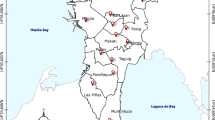Abstract
The characteristics of atmospheric PM10- and PM2.5-bound polycyclic aromatic hydrocarbons (PAHs) were investigated in Tongling city, China. Results showed that the total concentrations of PM10- and PM2.5-bound PAHs exhibited distinct seasonal and spatial variability. The metallurgic sites showed the highest PAH concentrations, which is mainly attributed to the metallurgic activities (mainly copper ore smelting) and coal combustion as the smelting fuel. The rural area showed the lowest concentrations, but exhibited significant increase from summer to autumn. This seasonal fluctuation is mainly caused by the biomass burning at the sites in the harvest season. The diagnostic ratio indicated that the main PAHs sources were vehicle exhausts, coal combustion and biomass burning. The total BaP equivalent concentration (BAP-TEQ) was found to be maximum at DGS site in winter, whereas it was minimum at BGC site in summer. Risk assessment indicates that residential exposure to PAHs in the industrial area, especially in the winter season, may pose a greater inhalation cancer risk than people living in living area and rural area.



Similar content being viewed by others
References
Ahad JME, Hautzy JJ, Cumming BF, Das B, Laird KR, Sanei H (2015) Sources of polycyclic aromatic hydrocarbons (PAHs) to northwestern Saskatchewan lakes east of the Athabasca oil sands. Org Geochem 80:35–45
Callén MS, Iturmendi A, López JM, Mastral AM (2014) Source apportionment of the carcinogenic potential of polycyclic aromatic hydrocarbons (PAH) associated to airborne PM10 by a PMF model. Environ Sci Pollut Res 21:2064–2076
Chen YJ, Feng YL, Xiong SC, Liu DY, Wang G (2011) Polycyclic aromatic hydrocarbons in the atmosphere of Shanghai, China. Environ Monit Assess 172:235–247
Ding X, Wang XM, Xie ZQ, Xiang CH, Mai BX, Sun LG et al (2007) Atmospheric polycyclic aromatic hydrocarbons observed over the North Pacific Ocean and the Arctic area: spatial distribution and source identification. Atmos Environ 41:2061–2072
Galarneau E (2008) Source specificity and atmospheric processing of airborne PAHs: implications for source apportionment. Atmos Environ 42:8139–8149
Guo XY, Li G, Gao Y, Tang L, Briki M, Ding HJ, Ji HB (2016) Sources of organic matter(PAHs and n-alkanes) in PM2.5 of Beijing in haze weather analyzed by combining the C–N isotopic and PCA–MLR analyses. Environ Sci 18:314–322
Jung KH, Yan BZ, Chillrud SN, Perera FP, Whyatt R, Camann D, Kinney PL, Miller RL (2010) Assessment of benzo(a)pyrene-equivalent carcinogenicity and mutagenicity of residential indoor versus outdoor polycyclic aromatic hydrocarbons exposing young children in New York city. Int J Environ Res Public Health 7:1889–1990
Katsoyiannis A, Sweetman A, Jones K (2011) PAH molecular diagnostic ratios applied to atmospheric sources: a critical evaluation using two decades of source inventory and air concentration data from the U.K. Environ Sci Technol 45:8897–8906
Li XX, Kong SF, Yin Y, Li L, Yuan L, Li Q, Xiao H, Chen K (2016) Polycyclic aromatic hydrocarbons (PAHs) in atmospheric PM2.5 around 2013 Asian Youth Games period in Nanjing. Atmos Res 174–175:85–96
Nisbet I, LaGoy P (1992) Toxic equivalency factors (TEFs) for polycyclic aromatic hydrocarbons (PAHs). Regul Toxicol Pharmacol 16:290–300
Ravindra K, Bencs L, Wauters E, Hoog JD, Deutsch F, Roekens E et al (2006) Seasonal and site specific variation in vapor and aerosol phase PAHs over Flanders (Belgium) and their relation with anthropogenic activities. Atmos Environ 40:771–785
Ravindra K, Sokhia R, Van Grieken R (2008) Atmospheric polycyclic aromatic hydrocarbons: source attribution, emission factors and regulation: a review. Atmos Environ 42:2895–2921
Robinson AL, Subramanian R, Donahue NM, Rogge WF (2006) Source apportionment of molecular markers and organic Aerosol 1. Polycyclic aromatic hydrocarbons and methodology for data visualization. Environ Sci Technol 40:7803–7810
Rogge WF, Hidemann LM, Mazurek MA, Cass GR, Simoneit BRT (1993) Sources of fine organic aerosol: 2. Noncatalyst and catalyst-equipped automobiles and heavy-duty diesel trucks. Environ Sci Technol 27:636–651
Wang JZ, Ho SSH, Cao JJ, Huang RJ, Zhou JM, Zhao YZ, Xu HM, Liu SX, Wang GH, Shen ZX, Han YM (2015) Characteristics and major sources of carbonaceous aerosols in PM2.5 from Sanya, China. Sci Total Environ 530–531:110–119
Wu SP, Tao S, Zhang ZH, Lan T, Zuo Q (2005) Distribution of particle-phase hydrocarbons, PAHs and OCPs in Tianjin, China. Atmos Environ 39:7420–7432
Yu QQ, Gao B, Li GH, Zhang YL, He QF, Deng W, Huang ZH, Ding X, Hu QH, Huang ZZ, Wang YJ, Bi XH, Wang XM (2016) Attributing risk burden of PM2.5-bound polycyclic aromatic hydrocarbons to major emission sources: case study in Guangzhou, south China. Atmos Environ 142:313–323
Yunker MB, Macdonal RW, Vingarzan R, Mitchell RH, Goyette D, Sylvestre S (2002) PAHs in the Fraser river basin: a critical appraisal of PAH ratios as indicators of PAH source and composition. Org Geochem 33:489–515
Zhou XH, Cao ZY, Ma YJ, Wang LP, Wu RD, Wang WX (2016) Concentrations, correlations and chemical species of PM2.5/PM10 based on published data in China: potential implications for the revised particulate standard. Chemosphere 144:518–526
Acknowledgements
The work was supported by National Key R&D Program of China (2016YFC0201600), National Natural Science Foundation of China (41403076, 41773099), Natural Science Foundation of Anhui Province (1604f0804001). We thank the editor Erin Bennett and anonymous reviewers for their thoughtful comments.
Author information
Authors and Affiliations
Corresponding author
Rights and permissions
About this article
Cite this article
Zhang, H., Wang, R., Xue, H. et al. Characteristic and Source of Atmospheric PM10- and PM2.5-bound PAHs in a Typical Metallurgic City Near Yangtze River in China. Bull Environ Contam Toxicol 100, 303–309 (2018). https://doi.org/10.1007/s00128-017-2217-0
Received:
Accepted:
Published:
Issue Date:
DOI: https://doi.org/10.1007/s00128-017-2217-0




